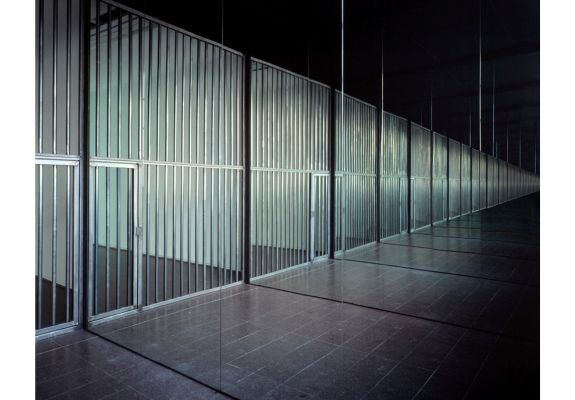Artist Birthday: Alfredo Jaar
Infinite Cell is a combination of mirrors and a single prison cell reflected infinitely. It is an ode to two Italian artists who were imprisoned for their Communist beliefs by the Fascists before World War II (1939-1945). Jaar believes that viewers' body language changes when they see themselves reflected multiple times in the jail cell setting. It is meant to encourage the viewer to ponder what they want to achieve in life and how that would change if their freedom were taken away.
Artist birthday for February 5th: Alfredo Jaar (Born 1961, Chile)
Alfredo Jaar is an installation artist whose work is conceptual and documents injustice, genocide, ongoing famine, and other major afflictions to humanity in many parts of the world.
 |
| Alfredo Jaar, Infinite Cell, 2004, iron bars, painted wood, and mirrors, 147.9 x 180.5 x 102.4" (375.6 x 458.4 x 260 cm) Courtesy of the Galerie LeLong and ART21, © 2025 Alfredo Jaar (ART21aj-176) |
The mirrors used in Infinite Cell and the resulting reflection and projection are meant to have the viewer think about the narcissism of Western culture (the mirror), and why exactly artists create and for whom. It also refers to the horrors of the 20th and 21st centuries in countries (most of them) where people have been oppressed.
Since the turn of the millennium, the word "global" is increasingly used to designate the state of art. Instead of most world cultures being narrowly defined by region and national borders, cultural ideas are exchanged easily from one part of the world to another. Enriching this exchange is the emergence, in post-colonial countries, of exploration through art of national, gender, social and political identity.
There is a tension between the perception that such globalization is long overdue in a world where nationalism spawned countless wars, and the fear that the phenomenon could level cultural difference to the point where some cultures would be consumed entirely by stronger entities. Artists have not ignored either of these scenarios. The themes that appear the most in contemporary art are questions of identity and ethnicity, race, gender, sexuality, and faith in terms of how they define human beings.
Alfredo Jaar's work explores the public's desensitization to photographic images and the limitations of art to document events such as genocide, epidemics, and political upheaval. He comes from a country which has experienced its own fair share of dictatorships, uprisings, revolutions and bloody retributions, not the least of which was the overthrow, condoned if not aided by the US, of a democratically elected Marxist government in the 1970s.
Jaar lived on Martinique between the ages of 6 and 16. He studied filmmaking at the Chilean-North American Institute of Culture (1979), and architecture at the University of Chile, Santiago (1981).Jaar's experiences in different regions of the world inform his art, documentations of notions of power, the imbalances of power between industrialized and developing countries, and the arbitrary boundaries contrasted with geography that reinforce systems of power and exploitation. Jaar's work has addressed such varied subjects as the holocaust in Rwanda, and the toxic pollution of Nigeria perpetrated by the exploitation of foreign oil companies.
This image is supplemental to the following Davis programs:
A Global Pursuit 2E, Unit 9 Artists Explore New Territory, 9.2 -- Skills and Techniques, Using Proportion and Scale
Beginning Sculpture, Chapter 7 Installation and Collaboration -- Principles of Design, Emphasis
The Visual Experience 4E, Chapter 11 Stretching Boundaries, 11.5 -- Installation Art
Davis Collections, Latinx Art, Central and South America

Comments